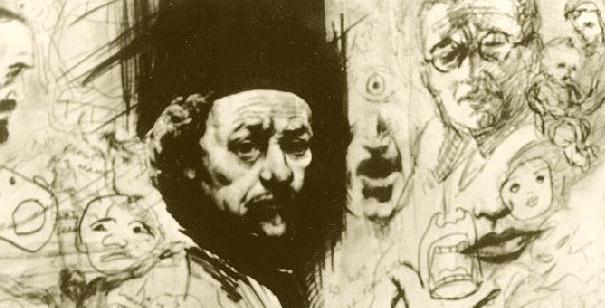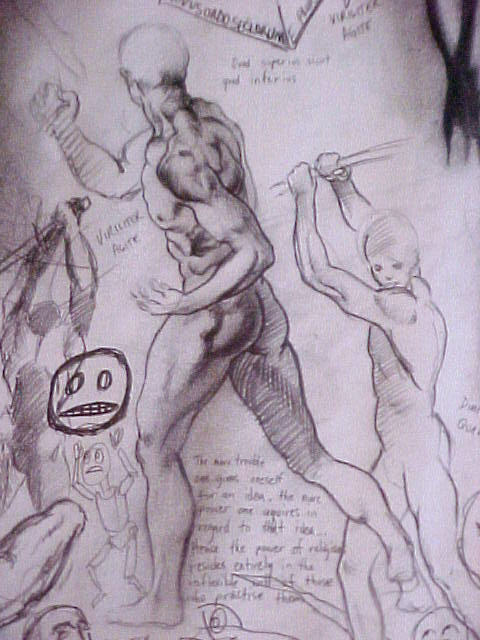

Mr. Mulhern was born in the city of New York in 1966.
Mr. Mulhern states:
He is a challenging interview; not abrasive, but reluctant to speak. He told the following story...


The nine year old boy lying in his hospital bed perked
up quickly, to the extent that he could, and smiled at
the entrance of his doctor. Dr. S. pulled out his wallet
and discretely passed his young patient a couple of dollars
that he quickly tucked under his pillow.
Having already reviewed the patient's chart, the doctor
began his in-person assessment. His expression moved
from concentration to relief. The boy's condition was improving.
Dr. S. moved his hand over the boy's head. "Has this stuff seen
a comb lately?" The patient lowered then shook his head with a
tight lipped smile. "You're looking pretty good except for this
'scare-do' you have. Do you know what a scare-do is? It's a
hairdo that's scary!" The boy's hair was matted and reaching
for the sky from the great duration of needed bed-rest. "I'm
sending you home this afternoon. I'll have your parents
come get you. Okay?" The boy nodded vigorously. "Good."
Dr. S. is a hematologic oncologist at a major teaching hospital.
His patients are cancer kids. In December 1995, I was an
advanced pre-med student and volunteer at the hospital. As a
result, I was presented with a splendid learning opportunity:
Dr. S. permitted me to follow him on rounds.
The day began at half past seven with the doctor from the
overnight shift bringing Dr. S. up to speed on his patients,
along with a review of new admittees. We then left his office
and proceeded on a long walk through underground tunnels to
the hospital proper. The place is dauntingly vast, a world
in itself. I tried to keep up with Dr. S.'s fast pace without
looking like too much of a clutz. I also tried to be as
unobtrusive as possible, remaining silent and writing extensive
notes on everything I saw and heard.
In spite of my better judgment, I did find myself asking
questions. Dr. S. answered questions happily and completely.
He was inadvertantly quite merciless to my ego, in fact,
because his answers were so detailed and precise that I could
finally plumb the prodigious depths of my ignorance. There
was so much I did not know about medicine and how bodies work.
I was getting a sinking feeling as I entertained the
possibility that I may not be capable of mastering such
a volume of complex information in a lifetime, let alone
in four more years of study. I shut off my mind's "doubt-speak"
and continued to look, listen and record.
The first patient of the day was the brave nine year old with
the winning smile and the untamed mane. Our exit from the boy's
room was informed with the doctor's quick lecture on
Von Willibrand's disease: Von Willibrand's factor VIII
deficiency presents like hemophilia, complete with mucocutaneous
bleeding and extra heavy mensing; treatment consists of an
anti-diuretic with an absurdly long acronym that increases the
synthesis of the limiting factor in endothelial cells.
I was still writing furiously when the doctor entered the
next room. The patient had difficulty breathing, and upon
examination presented an oregophany. Her lungs were
"solidifying," and she was prescribed "TPN" for eighteen hours.
Rounds continued rapidly. The next patient was Ashley. Her legs
were different temperatures; one was very hot. A blockage caused
by sickle-cell disease was the culprit. Then Travis, the picture
of courage after radiation and chemotherapy, was beginning a
regimen of granulocyte colony stimulating factor for neutropenia.
Another patient with a "conversion reaction" was to get a topical
anaesthetic "eutectic mixture of prilocaine and lidocaine" to
ease his needle squeamishness. A girl named Valerie needed a
spinal tap to check her CSF. There was a serious problem behind
every door Dr. S. walked through, and he always knew what
to do, quickly, to solve that problem.
One of the young resident physicians was doing his own rounds
when his path crossed that of Dr. S. A discussion resulted
about a patient presenting an adverse reaction. The resident
recognized the reaction immediately, calling for a change
in the type and dose of the patient's medication. Dr. S.
challenged the resident in a diagnostic definition. The resident
blanched before my eyes. He knew the disease and the medication
used, he spotted the adverse reaction and corrected it; but what
was the adverse reaction called? Dr. S. presented the question
to me as well, but he really wanted the answer from his resident.
I remained silent. The anxious resident looked to me for a
clue in my eyes, when Dr. S. broke the tension by answering his
own question. "Red man's syndrome," he said. And with that the
resident was embarrassed, deflated and defeated, apologizing for
his mental lapse and fully aware of the potential cost of it.
Dr. S. wasn't too easy on him. He's a tough teacher. The resident
volunteered a detailed summary of the status of his other
patients, displaying an encyclopedic knowledge, to regain the
confidence of the attending physician, and perhaps his own. The
summary was satisfactory and rounds continued.
I earned my insider's glimpse of the medical world a year earlier
than many students due to my academic record and volunteer time.
My volunteer activities at the hospital were unexciting, but
still a good preparation to acclimate myself to the vernacular
and environment of medicine. One of my tasks was a patient
transport to the children's wing. While waiting for the updated
chart to accompany the patient, I encountered a happy, playful
three year old in the hallway. This little girl looked
conspicuously healthy but for her lack of hair. I said hello to
her and waved. She picked up my cue, and in a fit of toddler
flirtatiousness, she accosted me with her toy lawnmower! We must
have been quite a sight: a six feet six inch, burly
twenty-something in a crisp shirt and tie, being chased around
the nurse's station by a toddler in footsie pajamas with a
plastic yellow lawnmower.
The thought of the healthy child came to me as I followed Dr. S.
to the room of the next patient, baby Jasmine. She was very
sick. She had been in and out of the hospital for most of her
short life. Even her family was losing hope. I didn't recognize
her at first, inanimate and unresponsive to all, but she was
the girl with the toy. Dr. S.'s instructions were as
straightforward as always in prescribing her therapeutic regimen.
What was unusual was that he was not certain of her recovery.
To have certainty in one's career, one should find a way
to make a living out of death or taxes. Such a view would
seem obvious to all but the most naive. Brilliance and
technology are not enough to save the world, and possibly not
even enough to save this little girl. A thick skin is required
of the professional. Dr. S. smiled as he entered the room of
the next patient.
February 24, 1997
Transfer from ferry to bus was made under cover of night. I took my place in the small, sepulchral, blissfully land-bound conveyance. My space in the crypt afforded me about three hours of fitless sleep, frequently interrupted by floating sensations. My feelings of discomfort were enhanced by the murky view out my window and the driver's general resemblance to a mythological character named Charon, a chauffeur to the underworld. "Wake up and go to sleep," I told myself.
The light of a new day eviscerates the power of the night's chiaroscuro conceits, leaving a beautiful tabula rasa full of promise for all who bother to experience it. It's a little after six in the morning, a cloudy sunrise, my bus looks like an ordinary coach, my driver looks like a regular bloke. My body's instinctive action is to pull a "just five minutes more, Mom," and return to the realm of the faeries, but I rise, quietly passing the rows of sleeping, dissheveled college students to exit the bus. In a nanosecond I hear the guide tell the driver we will continue to Paris at half past seven. The instantaneous translation of this to my mind was "It's time to explore."
Gosh it's cold. My strides are long and directed, although I have no idea where I am going. It's cold, yet it is not cold. My teeth are chattering like an old fire alarm and I'm shivering uncontrollably but I don't feel the cold; I feel like Christmas morning -- I feel brand new. It's about forty five degrees, I'm shivering, my hands are shoved way in the pockets of my windbreaker, and I'm taking longer and faster strides down a narrow cobblestone street towards the sunrise.
Rouen is an old city in France. It's old like nothing I have seen in the states. It has it's own Cathedral. It's older than my soul, and it will be here long after I have moved on. The place seems to have a heartbeat, a respiratory rate. And as the cloudy skies turn lavendar and pink with the quickening of the sun, I feel its pulse rate rise to the new day.
And the entire city smells like a fresh-baked croissant! My long legs bring me to a trot, then a full run down the narrow street. Birth! I emerge at the broad avenue. The clouds are a blanket over the still sleeping city. How can they still be sleeping? There's life going on; are they not afraid to miss it? Violet floats in the sky down the avenue at walking pace, "No hurry," says the city, "Life will not be missed."
I stand in the middle of the quiet, empty avenue, color moving across the clouds as one light, then two, then two more illuminate the windows of homes and bakeries along the avenue. I observe the domain come to life as if it were my own. I feel like a young prince who has secreted himself from the castle to observe the kingdom that will soon be his.
The scent of croissants has become intoxicating to this traveller. Alas, a bakery has unlocked its front door. I shall satiate my royal hunger! With something less than a mastery of the French language, I somehow emerged from the shop with a small bag of croissants without insulting anyone or signing a promissory note to purchase the Eiffel Tower.
My sense of royalty waned and my sense of reality waxed as I reembarked on the bus with the other dissheveled college kids. Still, I was given a glimpse of magic this day. I'm told that's how God generally works -- indirectly, quietly, but with style. I am aware.
And Rouen makes great croissants.
March 1997
2. Portrait of Sibyl, close-up
3. "Diner" oil painting, October 1999, about 16 x 20 in.
4. "Diner" close-up, October 1999
5. "Diner" close-up, October 1999
6. "Diner" close-up, October 1999
7. "Diner" close-up, October 1999
8. "Diner" close-up, October 1999
9. "Diner" oil painting, October 1999
10. "Diner" close-up, October 1999
11. portrait close-up, October 1999
12. October 1998, "Aletheia", about 30 x 40 in.
13. different light
14. Figure
15. Head
16. Color drawing
17. Head
18. vertical drawing, about 18 x 24 in.
19. close-up
21. Astaire and Hayworth, about 20 x 30 in.
22. close-up
24. close-up
25. Deer watercolor, about 20 x 30 in.
28. Landscape after Nolde, about 20 x 30 in.
29. Landscape after Sargeant, about 20 x 30 in, oil on canvas
30. superman, about 14 x 17 in.
31. hulk
32. marvel, about 14 x 17 in.
33. Painting: "Homage to Matisse", measures five feet across.
34. Oil Painting: "Still Life with Goldfish", 2001, 16 x 20 in.

